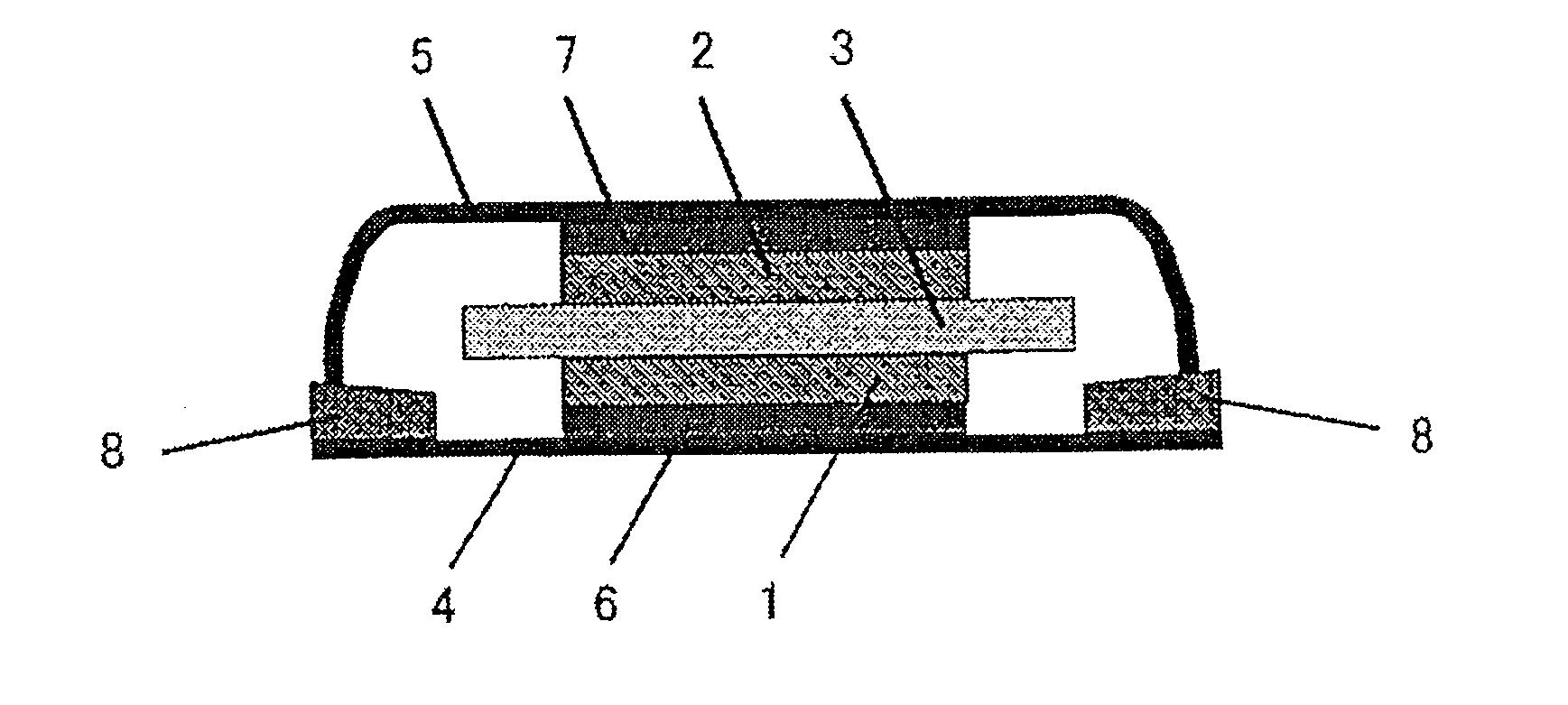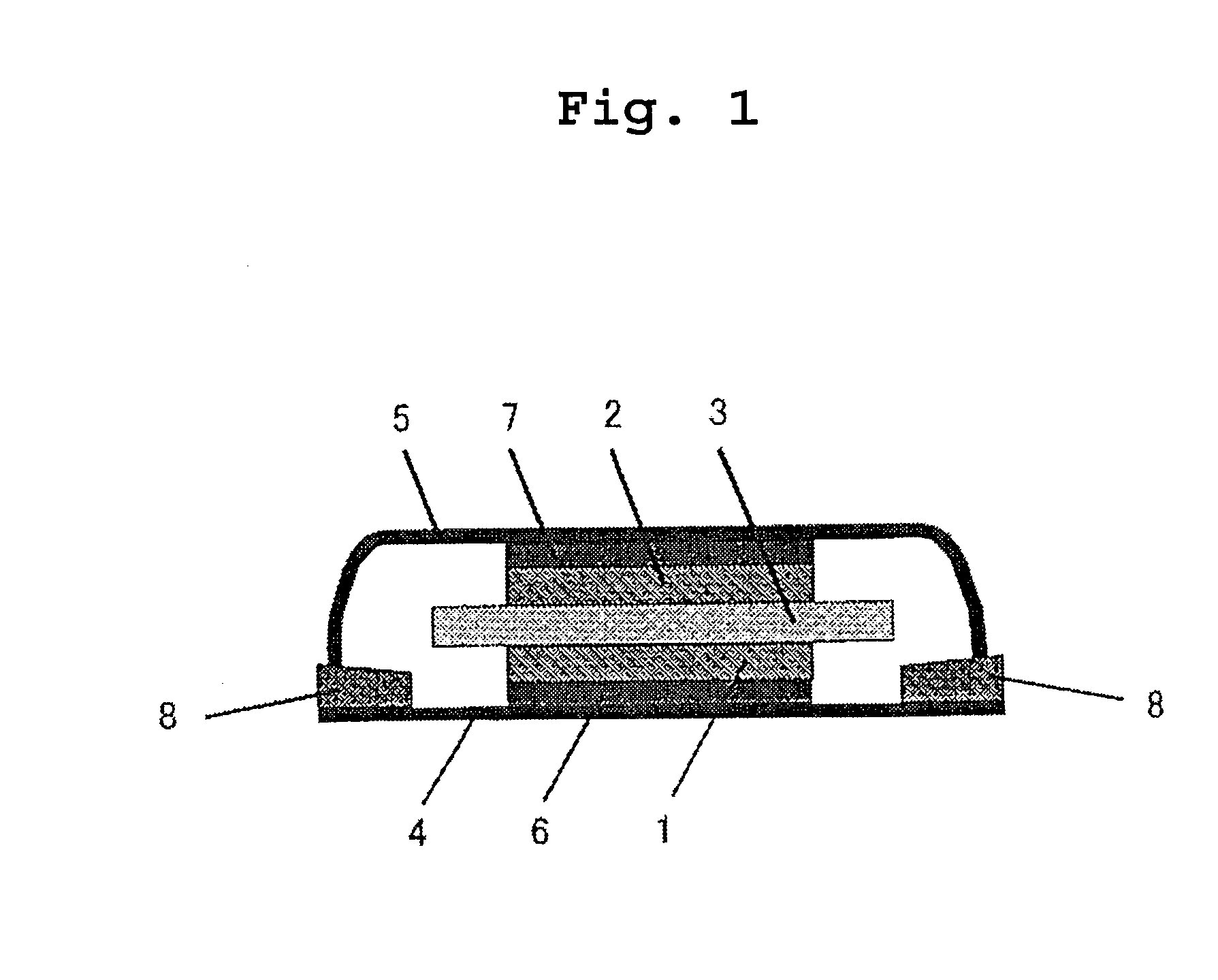Negative electrode for lithium secondary battery and lithium secondary battery
a secondary battery and negative electrode technology, applied in the direction of non-aqueous electrolyte cells, cell components, electrochemical generators, etc., can solve the problems of deteriorating current collection characteristics, charge and discharge cycle characteristics, and the volume of active materials including silicon increases and decreases, so as to inhibit the deterioration of current collectability and excellent charge and discharge characteristics
- Summary
- Abstract
- Description
- Claims
- Application Information
AI Technical Summary
Benefits of technology
Problems solved by technology
Method used
Image
Examples
experiment 1
[0041] (Experiment 1)
[0042] [Preparation of Negative Electrode]
[0043] 80.2 weight parts of silicon powder (active material a1) having a mean diameter of 2.4 .mu.m and an oxygen content and particle size distribution shown in Table 1 was added to 8.6 weight % of N-methylpyrrolidone solution containing 19.8 weight parts of polyamic acid as a binder to prepare a negative electrode slurry mixture.
[0044] The slurry was coated on one surface of an electrolytic copper foil (thickness: 35 .mu.m) having a surface roughness (Ra) of 0.5 .mu.m which is a current collector, and was rolled after drying. A disc having a diameter of 20 mm was cut out from the coated copper foil, and was sintered by heating at 400.degree. C. for 30 hours under an argon atmosphere to prepare a negative electrode. The thickness of the electrode (including the current collector) was 50 .mu.m. Therefore, the thickness of the active material layer was 15 .mu.m. Thickness of the active material layer (X) / surface roughness...
experiment 2
[0057] (Experiment 2)
[0058] Batteries A2 and B1.about.B3 were prepared in the same manner as Example 1 except that active materials a2 and b1.about.b3, respectively, having the mean particle diameters, oxygen contents and particle size distributions shown in Table 2 were used instead of the active material a1.
3TABLE 2 Oxygen Mean Particle Size Distribution (v %) Active Content Diameter of .gtoreq.1 .mu.m Material (w %) Particles (.mu.m) <1 .mu.m .ltoreq.10 .mu.m 10 .mu.m< a2 0.2 2.0 32 68 0 b1 0.2 1.2 43 57 0 b2 0.2 0.9 54 46 0 b3 0.2 12 8 49 43
[0059] [Evaluation of Charge and Discharge Cycle Characteristics]
[0060] Charge and discharge cycle characteristics of batteries A1, A2 and B1.about.B3 were evaluated. Each battery was charged to 4.2 V at a constant current of 1 mA and 25.degree. C., and then was discharged to 2.7 V at a constant current of 1 mA and 25.degree. C. (this is considered to be one charge and discharge cycle). The number of cycles to reach 80% of the discharge capac...
experiment 3
[0063] (Experiment 3)
[0064] The effect of oxygen content of silicon powder as the active material on irreversible capacity at initial charge and discharge was examined.
[0065] Battery A3 was prepared in the same manner as Example 1 except that active material a3 having the mean particle diameter, oxygen content and particle size distribution shown in Table 4, was used instead of the active material a1.
5TABLE 4 Oxygen Mean Particle Size Distribution (v %) Active Content Diameter of .gtoreq.1 .mu.m Material (w %) Particles (.mu.m) <1 .mu.m .ltoreq.10 .mu.m 10 .mu.m< a3 0.6 2.4 24 75 1
[0066] Cycle characteristics of battery A3 were evaluated in the same manner as described above. Cycle life is also shown when the cycle life of battery A1 is taken as 100. Charge-discharge efficiency of the first cycle of each of batteries A1 and A3 was also evaluated. The efficiency was calculated as follows:
Efficiency of the first cycle (%)=(discharge capacity of the first cycle / charge capacity of the f...
PUM
| Property | Measurement | Unit |
|---|---|---|
| particle size distribution | aaaaa | aaaaa |
| particle size distribution | aaaaa | aaaaa |
| diameter | aaaaa | aaaaa |
Abstract
Description
Claims
Application Information
 Login to View More
Login to View More - R&D
- Intellectual Property
- Life Sciences
- Materials
- Tech Scout
- Unparalleled Data Quality
- Higher Quality Content
- 60% Fewer Hallucinations
Browse by: Latest US Patents, China's latest patents, Technical Efficacy Thesaurus, Application Domain, Technology Topic, Popular Technical Reports.
© 2025 PatSnap. All rights reserved.Legal|Privacy policy|Modern Slavery Act Transparency Statement|Sitemap|About US| Contact US: help@patsnap.com


